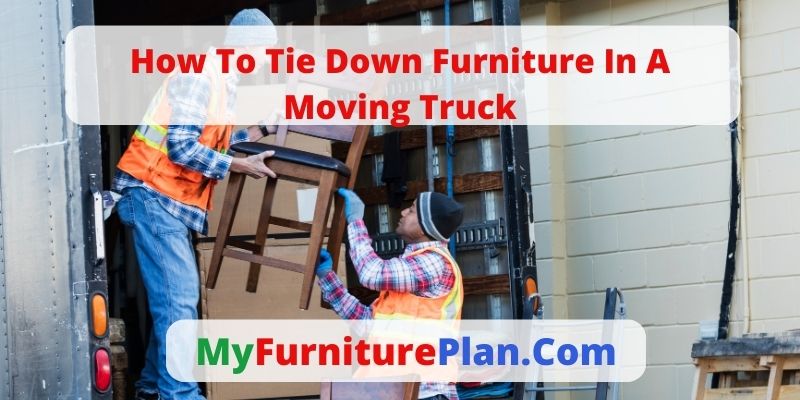Are you preparing for a move and wondering how to safely transport your furniture in a moving truck? Look no further! In this comprehensive guide, we will provide you with all the knowledge you need to securely tie down your furniture during transit. By following our step-by-step instructions, you can ensure that your valuable belongings arrive at their destination intact.
Firstly, it is crucial to assess the size and weight of your furniture to determine the appropriate equipment needed for securing them. We will help you choose the right tie-down straps based on different types of furniture and explain how to properly anchor them to the truck walls. Additionally, we will discuss the importance of using furniture blankets and padding for protection, as well as creating a stable base with larger pieces.
Furthermore, we will delve into securing mattresses and upholstered furniture effectively using ratchet straps for maximum security. Lastly, we will guide you through performing a final check before hitting the road.
With our expert advice, tying down your furniture in a moving truck has never been easier or more precise. Let’s get started!
Assessing the Size and Weight of Your Furniture
Before you start loading your furniture onto the moving truck, take a moment to assess how big and heavy each piece is. This step is crucial in evaluating transportation costs and calculating space requirements. Knowing the size and weight will help you determine the number of tie-downs needed and their placement for optimal security during transit. Measure each item carefully and consider any detachable parts that may require extra attention when securing them.
Choosing the Right Equipment for Securing Furniture
When it comes to ensuring the safety of your belongings during transport, having the proper gear is essential. Before you start securing your furniture in a moving truck, assess your equipment needs based on the size and weight of each item. Compare different tie down methods to determine which one will provide the most secure hold. Here is a table that highlights some common equipment options:
| Equipment | Pros | Cons |
|---|---|---|
| Ratchet straps | Secure and adjustable | Can be time-consuming to set up |
| Bungee cords | Quick and easy to use | May not provide enough tension for heavier items |
| Furniture blankets | Protects furniture from scratches | Does not provide direct tie-down support |
Choose the right combination of equipment based on your specific needs to ensure that your furniture stays in place during the move.
Understanding Different Types of Tie-Down Straps
To make sure your belongings stay secure during transport, it’s important to understand the various types of tie-down straps available. There are different types of tie-down straps that you can use to secure your furniture in a moving truck. These include ratchet straps, cam buckle straps, and bungee cords. Each type has its own benefits and is suited for different purposes. Using tie-down straps provides stability and prevents your furniture from shifting or falling during the move.
Properly Anchoring Furniture to the Truck Walls
Make sure you securely anchor your belongings to the walls of the truck to prevent any shifting or damage during transport. When it comes to securing heavy furniture, there are a few anchoring techniques you can use. Start by placing the furniture against the wall and using ratchet straps or bungee cords to secure it in place. Make sure to tighten the straps or cords properly, ensuring that the furniture is firmly anchored and won’t move during transit.
Using Furniture Blankets and Padding for Protection
Using furniture blankets and padding is essential for ensuring the protection of your belongings during transit. Properly securing your furniture with these materials will help prevent scratches, dents, and other damage that can occur during the move. Furniture padding acts as a cushioning layer between your valuables and the walls of the moving truck, reducing the risk of impact damage. By investing in high-quality padding, you can have peace of mind knowing that your items are well-protected throughout the journey.
Securing Drawers and Doors to Prevent Movement
Before you begin loading your furniture into the truck, it’s important to secure drawers and doors tightly so that they don’t swing open or slide out during transportation. Here are three key steps to ensure your drawers and doors stay in place:
- Use bungee cords or ropes to tie down any loose or removable drawers.
- Place furniture straps across the front of each drawer to keep them closed.
- Use door stoppers or wedges to prevent doors from swinging open.
By following these steps, you can safely secure your furniture and prevent any unwanted movement during the move.
Wrapping Fragile Items for Added Protection
To ensure the safety of your delicate belongings, carefully wrap fragile items in protective materials. Start by gathering bubble wrap or packing paper to provide a cushioning layer. Carefully place each delicate item on the material and wrap it securely, making sure there are no exposed areas. Secure the wrapping with tape to keep it in place during transportation. Don’t forget to label these items as fragile for extra caution when unpacking.
Distributing Weight Evenly in the Truck
When loading your possessions onto the truck, it’s important to ensure that the weight is evenly distributed for a smoother and safer journey. By distributing weight evenly in the truck, you can prevent furniture from shifting during transit. This can be achieved by placing heavier items towards the front of the truck and spreading them out across the width of the space. Use this table as a guide to distribute weight effectively:
| Item | Weight (lbs) | Placement |
|---|---|---|
| Couch | 150 | Towards front |
| Dining table | 100 | Middle |
| Bed frame | 75 | Back |
| Chairs | 50 | Spread out |
Following these guidelines will help maintain balance and stability, reducing the risk of damage to your furniture and ensuring a successful move.
Creating a Stable Base with Larger Furniture Pieces
As you start loading your belongings onto the truck, make sure to create a stable base by strategically positioning larger furniture pieces. This will help prevent any shifting or damage during transit. Here are some tips to ensure a secure base:
- Place heavy and sturdy items like dressers and cabinets towards the front of the truck.
- Use straps or bungee cords to secure mattresses and upholstered furniture to the walls of the truck.
- Stack chairs and smaller items on top of larger furniture to maximize space and stability.
- Fill in any gaps with soft items like pillows or blankets to minimize movement.
By following these steps, you can create a solid foundation that will keep your furniture safe during the move.
Securing Mattresses and Upholstered Furniture
Make sure you strap those comfy mattresses and cozy upholstered furniture securely to the walls of the truck so they can ride safely without any unexpected surprises. Preventing damage to delicate fabrics is crucial during the move. Use mattress bags or protective covers to shield them from dirt, dust, and potential tears. Additionally, secure loose cushions effectively by using bungee cords or straps to keep them in place and prevent them from shifting during transit.
Utilizing Ratchet Straps for Maximum Security
Now that you know how to secure mattresses and upholstered furniture, let’s discuss utilizing ratchet straps for maximum security. Ratchet straps are a reliable and efficient method of tying down furniture in a moving truck. They provide strong tension and can be adjusted easily. However, it is important to avoid common mistakes such as over-tightening or not properly securing the straps. We will also explore alternative tie-down methods for securing furniture.
Performing a Final Check before Hitting the Road
Before you embark on your journey, it’s crucial to perform a final check to ensure everything is secure and ready for the road ahead. Take a few moments to thoroughly inspect your tied-down furniture. Look for any loose or protruding parts that may pose a safety risk during transportation. Double-check all straps and tighten them if necessary. By performing this final inspection, you can have peace of mind knowing that your furniture is properly secured for the journey.
Frequently Asked Questions
What are some common mistakes people make when assessing the size and weight of their furniture before moving?
Common mistakes when assessing the size and weight of furniture before moving include underestimating weight, not measuring accurately, and overlooking disassembly options. It’s crucial to be thorough and precise to ensure a smooth moving process.
Are there any specific types of tie-down straps that are better for securing certain types of furniture?
When it comes to securing furniture, different types of tie-down straps are recommended based on the specific items you’re moving. Best practices involve using ratchet straps for heavy furniture and bungee cords or rope for lighter items.
How do you properly anchor furniture to the walls of a moving truck to prevent it from shifting during transit?
To properly anchor furniture and prevent shifting during a move, secure items to the walls of the moving truck using straps or ropes. Ensure tight and even tension, placing heavier items at the bottom for stability.
What are some additional steps you can take to protect fragile items during a move, aside from using furniture blankets and padding?
To protect fragile items during a move, in addition to using furniture blankets and padding, you can use bubble wrap or packing paper to individually wrap delicate items. Place them in sturdy boxes and label them as fragile for proper handling.
Is there a recommended order in which furniture should be loaded onto the truck to ensure weight is distributed evenly and the load remains stable?
To ensure weight distribution and stability, it is recommended to load heavy furniture first, towards the front of the truck. Then, place lighter items towards the back. This helps maintain balance and prevents shifting during transportation.
Conclusion
In conclusion, securing your furniture properly in a moving truck is crucial to ensure a safe and successful move. By assessing the size and weight of your furniture, choosing the right equipment, properly anchoring the furniture to the truck walls, using protective blankets and padding, creating a stable base, securing mattresses and upholstered furniture, utilizing ratchet straps for maximum security, and performing a final check before hitting the road, you can have peace of mind knowing that your belongings will arrive at their destination intact. Happy moving!


